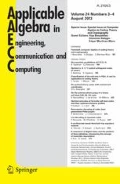Abstract
We demonstrate that recent advances in the theory of braid groups, in particular a new invariant of conjugacy classes of braids, the ultra summit set, make some braid-based cryptographic protocols insecure for almost all randomly chosen keys. As part of this we present an overview of the known algorithms for solving the conjugacy decision and search problems in braid groups and an assessment of their practical performance from the point of view of braid-based cryptography.
Similar content being viewed by others
References
Anshel, I., Anshel, M., Fisher, B., Goldfeld, D.: New key agreement protocols in braid group cryptography. In: Topics in cryptology – CT-RSA 2001 (San Francisco, CA). Lecture notes in computer science, vol 2020, pp 13–27. Berlin Heidelberg New York: Springer (2001)
Anshel I., Anshel M., Goldfeld D. (1999) An algebraic method for public-key cryptography. Math Res Lett 6(3–4): 287–291
Artin E. (1947) Theory of braids. Ann Math 48(2): 101–126
Birman J.S., Ko K.H., Lee S.J. (2001) The infimum, supremum, and geodesic length of a braid conjugacy class. Adv Math 164(1): 41–56
Bosma W., Cannon J., Playoust C. (1997). The MAGMA algebra system I: the user language. J Symbolic Comput 24, 235–265 http://www.magma.maths.usyd.edu.au/magma/
Cha, J.C., Ko, K.H., Lee, S.J., Han, J.W., Cheon, J.H. An efficient implementation of braid groups. In: Advances in cryptology – ASIACRYPT 2001 (Gold Coast). Lecture notes in computer science, vol 2248, pp 144–156. Berlin Heidelberg New York: Springer (2001)
Cheon, J.H., Jun, B. A polynomial time algorithm for the braid Diffie–Hellman conjugacy problem. In: CRYPTO: Proceedings of Crypto (2003) (in press)
Dehornoy, P. Braid-based cryptography. In: Myasnikov, A., Shpilrain, V., (eds.) Group theory, statistics and cryptography. Contemporary mathematics, vol 360, pp 5–33. American Mathematical Society (2004)
El-Rifai, E.A., Morton, H.R. Algorithms for positive braids. Q J Math Oxford Ser. (2) 45(180), 479–497 (1994)
Epstein D.B.A., Cannon J.W., Holt D.F., Levy S.V.F., Paterson M.S., Thurston W.P. (1992) Word processing in groups, chap. 9. Jones and Bartlett Publishers, Boston, MA
Franco N., González-Meneses J. (2003) Computation of centralizers in braid groups and Garside groups. Rev Mat Iberoamericana 19(2): 367–384
Franco N., González-Meneses J. (2003) Conjugacy problem for braid groups and Garside groups. J Algebra 266(1): 112–132
Garber, D., Kaplan, S., Teicher, M., Tsaban, B., Vishne, U. Length-based conjugacy search in the braid group. Preprint. Available at http://www.arxiv.org/math.GR/0209267 (2002)
Garside, F.A. The braid group and other groups. Q J Math Oxford Ser (2)20, 235–254 (1969)
Gebhardt V. (2005) A new approach to the conjugacy problem in Garside groups. J Algebra 292(1): 282–302
González-Meneses, J., Wiest, B. On the structure of the centralizer of a braid. Ann Sci Ec Norm Super, IV. Ser 37, No 5, 729–757 (2004)
Hofheinz, D., Steinwandt, R. A practical attack on some braid group based cryptographic primitives. In: Public key cryptography, 6th international workshop on practice and theory in public key cryptography, PKC 2003. Lecture notes in computer science, vol 2567, pp 187–198. Berlin Heidelberg New York: Springer (2003)
Hughes, J. A linear algebraic attack on the AAFG1 braid group cryptosystem. In: The 7th Australasian conference on information security and privacy, ACISP 2002. Lecture notes in computer science, vol 2384, pp 176–189. Berlin Heidelberg New York: Springer (2002)
Hughes, J., Tannenbaum, A. Length-based attacks for certain group based encryption rewriting systems (2002)
Ko, K.H., Lee, S.J., Cheon, J.H., Han, J.W., Kang, J.-S., Park, C. New public-key cryptosystem using braid groups. In: Advances in cryptology – CRYPTO 2000 (Santa Barbara, CA). Lecture notes in computer science, vol 1880, pp 166–183. Berlin Heidelberg New York: Springer (2000)
Lee, S.J., Lee, E. Potential weakness of the commutator key agreement protocol based on braid groups. In: EuroCrypt 2002. Lecture notes in computer science, vol 2332, pp 14–28. Berlin Heidelberg New York: Springer (2002)
Lee, E., Lee, S.J., Hahn, S.G. Pseudorandomness from braid groups. In: Advances in cryptology – CRYPTO 2001 (Santa Barbara, CA). Lecture notes in computer science, vol 2139, pp 486–502. Berlin Heidelberg New York: Springer (2001)
Sidel’nikov V.M., Cherepnev M.A., Yashchenko V.V. (1993) Public key distribution systems based on noncommutative semigroups. Dokl Akad Nauk 332(5): 566–567
Thurston W.P. (1988) On the geometry and dynamics of diffeomorphisms of surfaces. Bull Am Math Soc (NS) 19(2): 417–431
Author information
Authors and Affiliations
Corresponding author
Rights and permissions
About this article
Cite this article
Gebhardt, V. Conjugacy Search in Braid Groups. AAECC 17, 219–238 (2006). https://doi.org/10.1007/s00200-006-0008-7
Received:
Revised:
Published:
Issue Date:
DOI: https://doi.org/10.1007/s00200-006-0008-7




